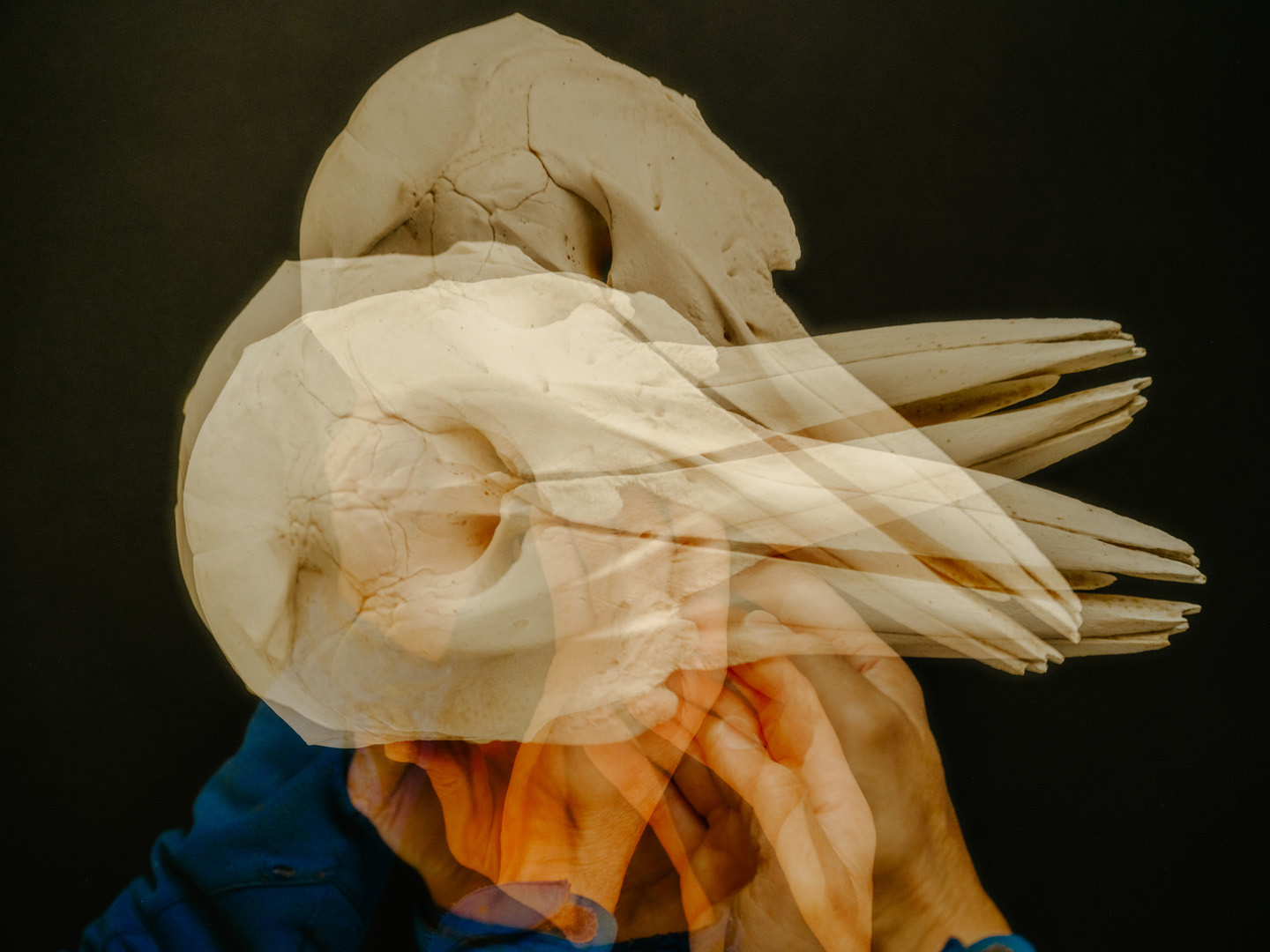Mike deRoos is standing beside the skeleton of an eight-metre-long minke whale. The beast’s massive jaws are stretched open, slicing through the air above his head. “I’ve captured her body in a half-roll as she lunge-feeds through a swarm of krill,” deRoos says. “People see so little of these animals’ bodies because they live beneath the water. I wanted to restore her beauty and her grace. It’s all about motion.”
DeRoos calls himself a “skeleton articulator.” If his vocation is unique, so too is his approach. Before assembling a skeleton, he does copious research, uncovering details about the lives and deaths of his subjects. This minke has three broken ribs, damaged by the transient killer whales that chased her into Echo Bay, on B.C.’s Central Coast, in 2004, where she was beached and died.
“I’ve seen skeletons all over the world, and they look like dead animals. But the way Mike puts them together, it’s like they’re still living.” —Andrew Trites
The minke is one of half a dozen of deRoos’s creations floating in the air above the second floor of the Aquatic Ecosystems Research Laboratory (AERL) at UBC. Directly above us is a diving killer whale with a skull full of jagged teeth, and off to our right, three Pacific white-sided dolphins are dancing beside the staircase. These sculptures are held aloft by thin, stainless-steel cables that are nearly invisible to the eye, their bones and cartilage artfully fused so that the armature that binds them together like beads on a string is unseen. The effect is magical.
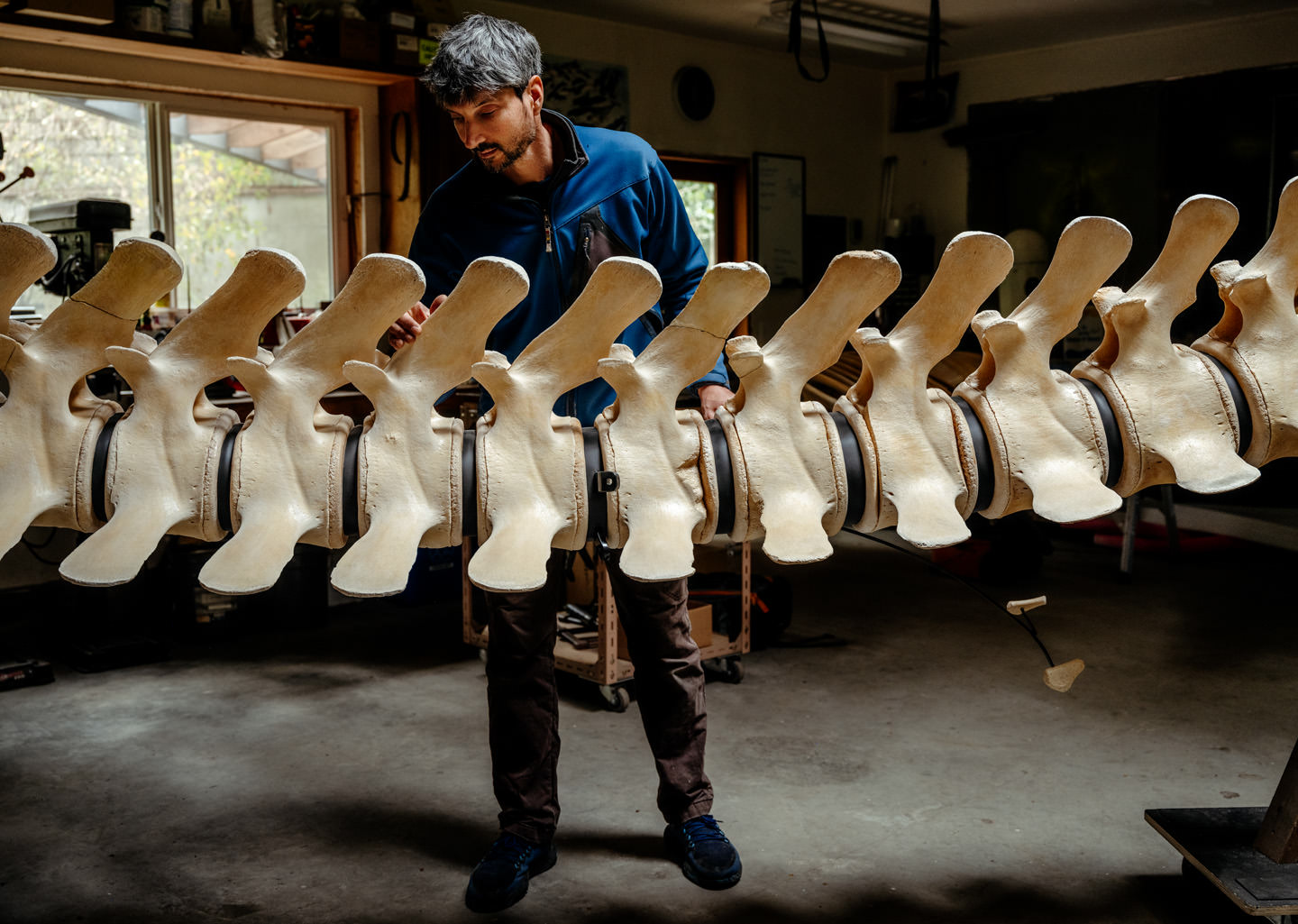
Mike deRoos with the lumbar spine from a young 13-metre-long fin whale found near Pender Harbour.
All these pieces were commissioned by Andrew Trites, a UBC zoology professor and the director of the school’s Marine Mammal Research Unit. Trites is an unabashed admirer of deRoos’s work, particularly his ability to somehow breathe life into the bones. “I’ve seen skeletons all over the world, and they look like dead animals. But the way Mike puts them together, it’s like they’re still living,” he says. “He is a master articulator, and his signature is the way in which he takes something static and he makes it move.”
DeRoos, who has a degree in biology, has other specimens on display at UBC, including an enormous 26-metre-long blue whale that hangs in the Beaty Biodiversity Museum. The leviathan was found on a beach in Prince Edward Island in 1987. Two decades later, the project to dismantle its 80,000-kilogram carcass and transport the bones across the country for cleaning, design, and installation became the subject of a Discovery Channel documentary, Raising Big Blue. A show-stopping sight and engineering marvel, it is the largest internally supported suspended skeleton in the world.
More of deRoos’s cutting-edge creations can be found in museums in England, Australia, the U.S., and various locations in B.C. Many were constructed at his studio, which sits beside the property he shares with his wife and two daughters on Saltspring Island. Their small, specialized company is called Cetacea Contracting. His wife, Michiru Main, who is also a biologist, works as project manager and assistant articulator on his various endeavours.
Folding his tall, lanky frame into a chair, deRoos sits back to discuss his profession in calm, measured tones. His name is Dutch, and with his angular features, hawkish nose, and trimmed moustache and goatee he looks like he might have just walked out of a Rembrandt. He regards his work as a combination of science, art, engineering, metal fabrication, sculpting, and painting. There is no school for this. He picked it up on the fly, blending a knack for puzzle solving with biological insights, manual dexterity, stubborn determination, and a strong constitution. In the past he had to supplement the business with work as a carpenter and welder, but he no longer needs to. However, he still serves as a field technician on marine mammal projects, where he is valued for his rare ability to affix suction cameras to the flanks of swimming whales.
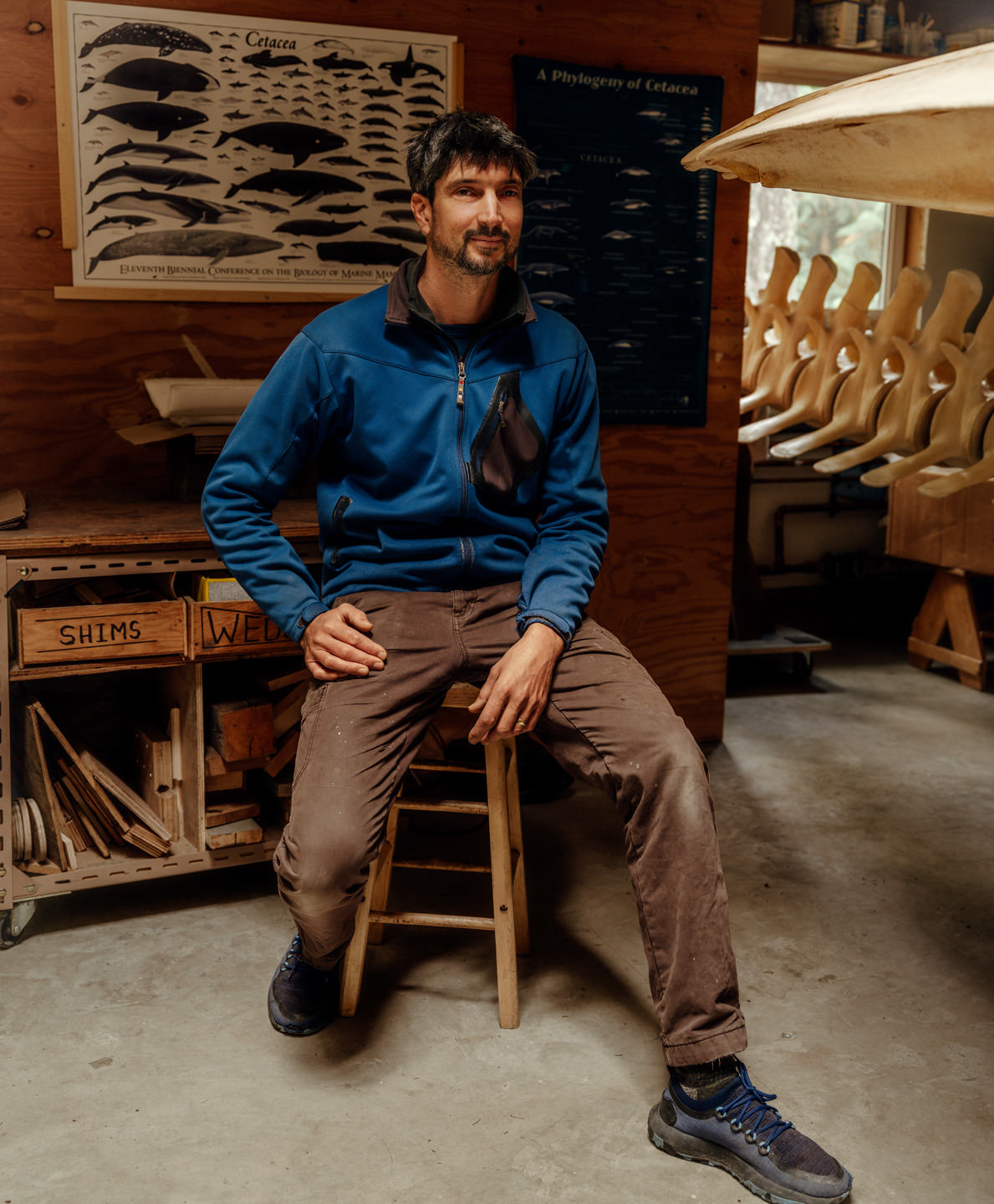
Mike deRoos in his workshop.
DeRoos traces his fascination with nature and animal bones to his Vancouver childhood when he would go scavenging with his grandfather, a surgeon. They would bring home their prizes and dissect them. He also learned valuable building skills from his father, a general contractor.
The first skeleton he built was a sea otter, which he assembled during a six-week course at the Bamfield Marine Sciences Centre while attending the University of Victoria in 2000. That led to a summer job in Telegraph Cove, where he constructed skeletons for Jim Borrowman, who opened the village’s Whale Interpretive Centre in 2002.
Today, the projects often begin with a phone call. A whale has washed up on a beach. Does he want to take a look? Such is the case with his latest piece, a 13-metre-long fin whale whose body was found in a cove near Pender Harbour. After government scientists finished their necropsy, the corpse was towed to a wharf by members of the shíshálh Nation, who were keen on having the skeleton displayed at their Tems Swiya Museum in Sechelt. DeRoos arrived with a crew and removed the flesh with flensing knives. The bones were then broken down into individual pieces and taken to Saltspring, where they were buried in horse manure for six months.
During the cleaning process, all oil must be removed from the bones and—as oil can comprise as much as 40 per cent of a whale’s weight—there is a lot of it. The bones cook for six to eight months until the microbes have consumed much of the viscous liquid, after which they are put into a hot vapour degreaser—a device used to clean airplane engines. It’s an ungainly piece of machinery that deRoos must haul down the road on a trailer to plug in at a welding shop, but it’s effective. “We can clean a killer whale skeleton like that in about three or four days, like one hundred per cent oil free.”
DeRoos initially sketched out the design for each specimen with pencil and paper, but in the last decade he has been using laser scanning technology supplied by Victoria’s Camosun College. He has also been experimenting with virtual reality software that he hopes will enhance the experience of people viewing his skeletons.
“They could take an iPad and hold it up in front of the skeleton and then put the skin on and the muscles, or press the play button and have it actually start swimming on the screen.”
He puts considerable thought into how he will pose a skeleton. In essence, he wants to grant the dead a second life. “At the heart of it, I’m a conservationist. I want to see people care about the environment and try and protect it. And so that’s what I’m trying to do with the skeletons—they’re sort of ambassadors for the actual living animals to speak to people that will come and see them.”
He is also careful to ensure that his cables will withstand the weight of the installations. “I overbuild everything,” he says, adding that he uses at least four times the breaking strength required. That way, “I can sleep at night knowing that I’m not going to kill someone with a skeleton falling on them.”
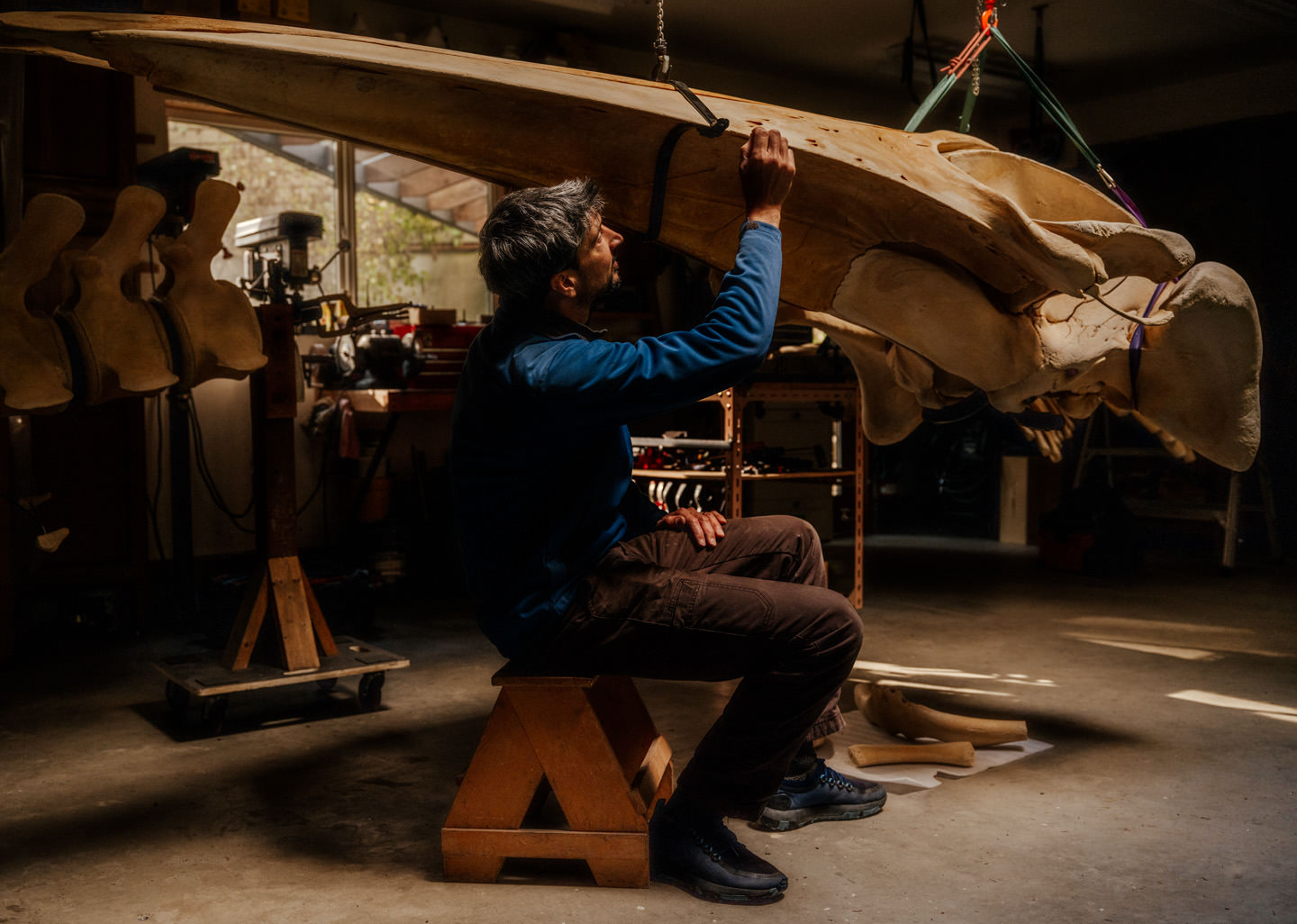
The fin whale’s skull.
The Sechelt fin whale is a major piece. Fin whales are the second-largest cetacean, after blue whales. Both species are gulp feeders, plunging with wide-open mouths into schools of krill to scoop up huge quantities of food and water. They then sieve the water out through their baleen plates before ingesting their meal.
“They’re known as the greyhounds of the sea. They’re sleek and fast with slender bodies, small flippers and sharp, pointed heads,” deRoos says. This specimen will be posed rolling on its side in a gulp-feeding posture.
Once this project is complete, deRoos will construct a Risso’s dolphin and a pygmy sperm whale for the interpretive centre in Telegraph Cove, then start on a new cluster of skeletons for the AERL building, including an elephant seal, a harbour porpoise, two Dall’s porpoises, and a humpback whale, a species hunted to near-extinction in the mid-1900s that is now making a comeback.
The plan is to depict the humpback engaged in bubble-net feeding, a cooperative feeding strategy in which whales dive below a school of fish and then spew a cascade of bubbles from their blowhole to stun and corral the fish into an ever-shrinking spiral, while the other whales surge upward with mouths agape to engulf their prize. The nine-metre-long humpback would be suspended vertically in the building’s atrium, extending from the first floor to the top floor of the four-storey structure. If successful, this installation would be the first of its kind in the world.
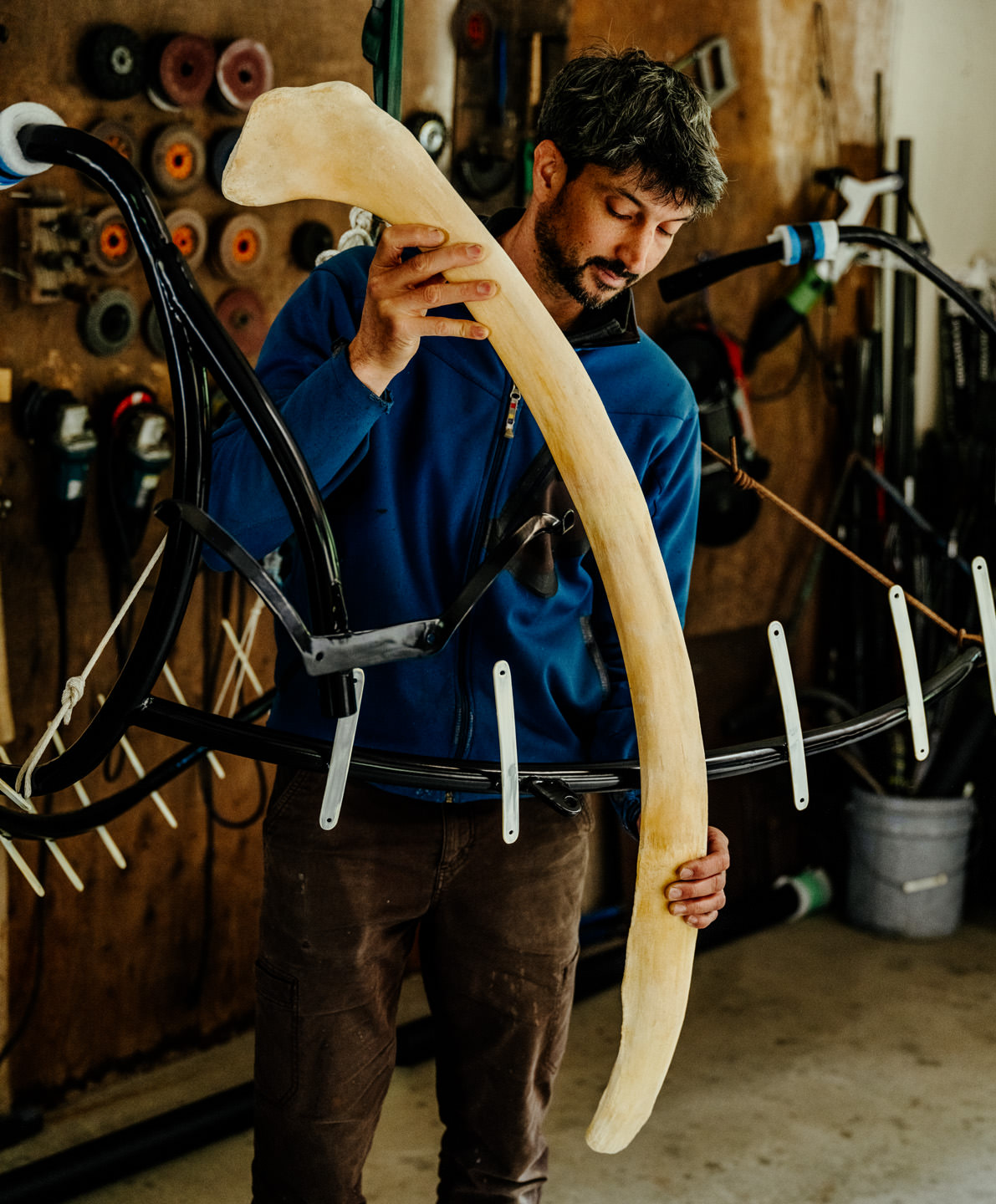
A single rib bone, which will be attached to a metal rib cage armature.
Mounting the skeleton, which weighs about 400 kilograms, poses some serious engineering challenges, but deRoos is confident he can overcome them. His goal with the humpback, as with all his handcrafted creations, is to offer a glimpse into their underseas behaviour and to inspire awe at nature’s beauty. “As a young biologist, I first witnessed bubble-net feeding in Icy Strait, Alaska. We counted 23 whales cooperating, and I was absolutely amazed at this massive eruption of white water, whales, and herring. It absolutely dwarfed our 22-foot boat,” deRoos says. The drama was heightened when they put a hydrophone in the water. By listening to the whales’ calls, they could predict the appearance of the bubble net, a ring of fizzing bubbles 20 to 30 metres in diameter. Then fleeing fish broke the surface, followed seconds later by the mass of gaping mouths and bodies of the giant whales.
“I’ve witnessed bubble-net feeding many times since, but never have I seen so many whales working together,” he continues. “Few people get to witness these events first-hand, so my hope with this installation is to capture people’s interest and imaginations, inspire them to learn how incredible and complex our natural world is and what we have to lose if we fail to face the destruction we’re causing to our planet.”
Read more from our Winter 2024 issue.

